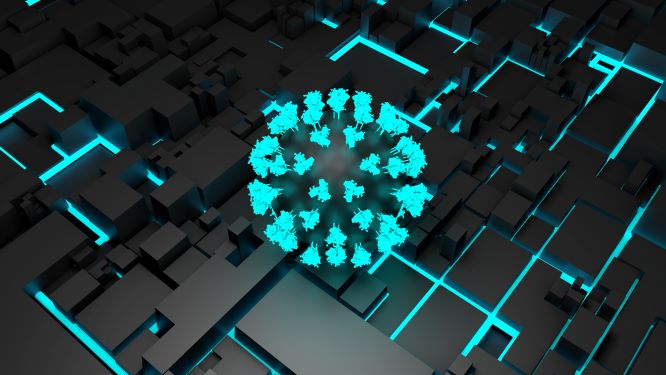How artificial intelligence helps to fight the pandemic, and why it is not the solution
by Jessy de Cooker
In the first days of this year, the World Health Organization and the US Centers for Disease Control and Prevention notified the world of a flu-like outbreak in China. A Canadian health monitoring platform, however, beat these institutions and had already sent word of the outbreak out to its government, business, and public health clients on December 31, 2019. This company, BlueDot, uses artificial intelligence (AI) that analyses foreign-language news reports, animal and plant disease networks, and official proclamations to give its clients advance warning to avoid danger zones. And the virus it identified was the corona virus, which since has spread globally.
Supercomputers against corona
Tracking infectious disease risks using AI is one of the many ways in which the technology has been deployed over the last couple of months in the fight against the coronavirus (COVID-19). For example, the Chinese AI start-up Infervision launched an AI solution that aids front-line healthcare workers detect and monitor the disease efficiently.
Also, the DeepMind division of Google and IBM’s supercomputer Summit deploy computing power to understand the proteins that might make up the virus. And Healx, a Cambridge company set up by Viagra co-inventor Dr David Brown, repurposed its AI system developed to find drugs for rare diseases. Within weeks, IBM’s Summit and Healx’s system came up with results. These systems illustrate the power of AI to speed up processes that would take humans literally ages. Subsequently, AI enables the analysis of massive amounts of data. For example, Utrecht University uses the university’s ASReview software to help physicians and researchers find the right texts in the COVID-19 Open Research Dataset (CORD-19), a dataset of 63,000 studies on the new coronavirus that may answer a question more quickly in the thousands of studies on the coronavirus.
Here lies the crucial contribution of AI in the fight against the coronavirus. However, it must also be acknowledged that, although AI can contribute to averting the corona crisis, it is not the solution.
According to the European Union definition, AI ‘endows systems with the capability to analyse their environment and take decisions with some degree of autonomy to achieve goals’. Artificial intelligence systems depend on vast amounts of prior data to train computers how to interpret new facts. The technology has advanced greatly since the SARS-outbreak in 2003, for example.

Long-term promises fulfilled?
However, AI also has previously proved to be a long-term promise and it is flooded with overstrained expectations that it cannot simply, and certainly not in the short term, meet. Last March, Glen Weyl and Jaron Lanier, researchers at Microsoft, even claimed that AI should be seen as ‘an Ideology’ and not as a technology. “Software benefits from an air of magic, lately, when it is called AI. If “AI” is more than marketing, then it might be best understood as one of a number of competing philosophies that can direct our thinking about the nature and use of computation,” they wrote in Wired.
One of the issues that continuously recur is that you need enormous amounts of reliable data for many applications. When it comes to medical analyses and predictive technology, there is promise. However, in the case of COVID-19, there are still countries that do not display their corona figures transparently. Iran is one of these countries. BBC Persia discovered that the number of deaths from coronavirus in the country is nearly triple what Iran’s government claims. The government’s own records appear to show almost 42,000 people died with Covid-19 symptoms up to 20 July, versus 14,405 reported by its health ministry. Without good input, algorithmic systems do not show the reliance needed to properly fight the virus. These kinds of structural and political problems or shortcomings in data collection cannot be solved by artificial intelligence. Change on a political and social level is essential in addressing this fundamental flaw.
‘It’s about ecology, people’s behavior, and unforeseen factors’
AI systems can really play a role in predicating, diagnosing and treating disease, and in performing essential actions more safely. They also facilitate the formulation of predictions how infections will develop, where the hotbeds will arise and how the virus will spread. This requires information about the carriers, where and with whom they come into contact.
And this touches upon the fact that AI should be approached with a sense of reality. The root of infectious diseases is social interaction.
In that regard, Roel Coutinho, medical doctor, microbiologist and former director of the Dutch Centre for Infectious Disease Control, stated in the Dutch opinion programme Buitenhof: ‘You would like to think that you can prevent this completely, but this is extremely difficult because every time there are unknown factors that we didn’t think would play a role. It’s complex, it’s about ecology, people’s behaviour, and unforeseen factors. Every epidemic is different.”
With regard to COVID-19, it can be argued that technologies as AI can contribute to solutions, but the social mechanisms – from adhering to quarantine obligations to wearing (or not wearing) a face mask in busy public areas – play the greatest role.
China’s mass experiment
As long as a vaccine or effective drug has not yet been developed, governments around the world seek the solution in infection prevention. Artificial intelligence also plays a major role in this. It offers the possibility to control much more closely than before. Since China encouraged its people to return to work last March, it also began a mass experiment in using data to regulate citizens’ lives — by requiring them to use software on their smartphones that dictates whether they should be quarantined or allowed into subways, malls and other public spaces. These tracking systems could prove to be unreliable and ineffective, as citizens could be wrongly labelled as a risk of infection, and people can carry the virus with them without knowing it.
These developments are observed with suspicion by minorities that fear that the surveillance systems that are being erected during the coronavirus outbreak will be upheld by governments and tech companies in the name of public health. “The coronavirus outbreak is proving to be a landmark in the history of the spread of mass surveillance in China,” Maya Wang, a China researcher for Human Rights Watch, claimed in The New York Times. Also, the use of AI to predict the spread of the virus could lead to worrisome situations. For example, AI analysis could lead to a quarantine of large groups of people, while the system could increasingly be biased when it comes to specific groups of people. Technologies could also be used to assess if this quarantine is being upheld, like Chinese drones that kept an eye out for violations of stay-at-home restrictions.
No intelligence is ever autonomous
All in all, the potential of AI in the ‘fight against the coronavirus’ is huge, and the technology can be helpful in many areas. The technology will however not be the sole solution to COVID-19, but in accordance with an interdisciplinary approach based on real world experiences, cognitive flexibility, common sense and context-aware knowledge it can be helpful in many disciplines. Its deployability needs to be scrutinised critically.
No intelligence – human or machine – is ever truly autonomous. As described above, AI is a result of social context and in its influence in the corona crisis, it is dependent on human actions like (dis)obeying governmental corona rules and data input. The key is to understand AI as the subjective entity that it is, and not to merely approach it as the miracle cure in the fight against COVID-19.
Jessy de Cooker is a Dutch freelance journalist, podcast maker and New Media and Digital Culture MA.
Title image by cottonbro via Pexels
Image in text by Design_Cells via Shutterstock


